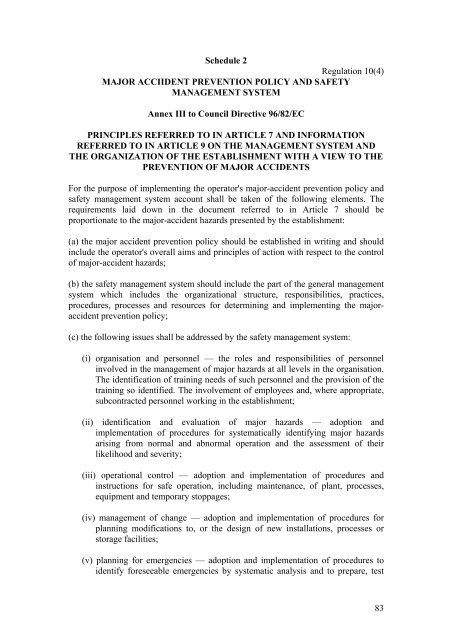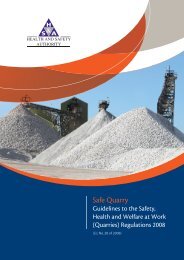Control of Major Accident Hazards Involving Dangerous Substances
Control of Major Accident Hazards Involving Dangerous Substances
Control of Major Accident Hazards Involving Dangerous Substances
Create successful ePaper yourself
Turn your PDF publications into a flip-book with our unique Google optimized e-Paper software.
Schedule 2<br />
Regulation 10(4)<br />
MAJOR ACCIIDENT PREVENTION POLICY AND SAFETY<br />
MANAGEMENT SYSTEM<br />
Annex III to Council Directive 96/82/EC<br />
PRINCIPLES REFERRED TO IN ARTICLE 7 AND INFORMATION<br />
REFERRED TO IN ARTICLE 9 ON THE MANAGEMENT SYSTEM AND<br />
THE ORGANIZATION OF THE ESTABLISHMENT WITH A VIEW TO THE<br />
PREVENTION OF MAJOR ACCIDENTS<br />
For the purpose <strong>of</strong> implementing the operator's major-accident prevention policy and<br />
safety management system account shall be taken <strong>of</strong> the following elements. The<br />
requirements laid down in the document referred to in Article 7 should be<br />
proportionate to the major-accident hazards presented by the establishment:<br />
(a) the major accident prevention policy should be established in writing and should<br />
include the operator's overall aims and principles <strong>of</strong> action with respect to the control<br />
<strong>of</strong> major-accident hazards;<br />
(b) the safety management system should include the part <strong>of</strong> the general management<br />
system which includes the organizational structure, responsibilities, practices,<br />
procedures, processes and resources for determining and implementing the majoraccident<br />
prevention policy;<br />
(c) the following issues shall be addressed by the safety management system:<br />
(i) organisation and personnel — the roles and responsibilities <strong>of</strong> personnel<br />
involved in the management <strong>of</strong> major hazards at all levels in the organisation.<br />
The identification <strong>of</strong> training needs <strong>of</strong> such personnel and the provision <strong>of</strong> the<br />
training so identified. The involvement <strong>of</strong> employees and, where appropriate,<br />
subcontracted personnel working in the establishment;<br />
(ii) identification and evaluation <strong>of</strong> major hazards — adoption and<br />
implementation <strong>of</strong> procedures for systematically identifying major hazards<br />
arising from normal and abnormal operation and the assessment <strong>of</strong> their<br />
likelihood and severity;<br />
(iii) operational control — adoption and implementation <strong>of</strong> procedures and<br />
instructions for safe operation, including maintenance, <strong>of</strong> plant, processes,<br />
equipment and temporary stoppages;<br />
(iv) management <strong>of</strong> change — adoption and implementation <strong>of</strong> procedures for<br />
planning modifications to, or the design <strong>of</strong> new installations, processes or<br />
storage facilities;<br />
(v) planning for emergencies — adoption and implementation <strong>of</strong> procedures to<br />
identify foreseeable emergencies by systematic analysis and to prepare, test<br />
83
















